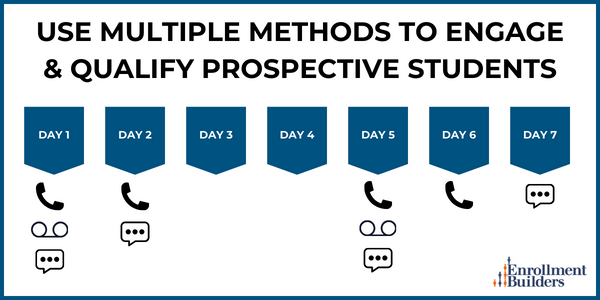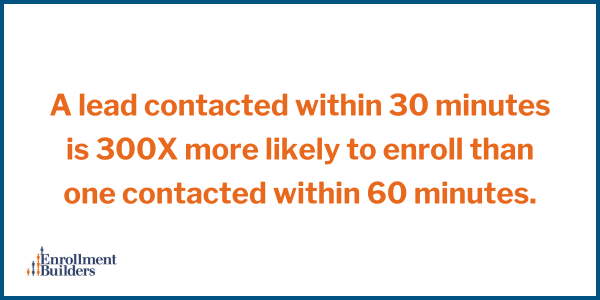Are you concerned that your current contact strategies are letting potential students slip through...
5 Steps to Increase Student Enrollment in Higher Ed Institutions
Are you feeling pressure about not hitting your enrollment goals this year? Have you exhausted all of your ideas to improve your admissions strategy and processes?
At Enrollment Builders, we hear these struggles from admissions leaders on a regular basis. To help you take back control and improve your enrollment, we’ve compiled a list of enrollment management best practices.
In this article, you’ll discover five effective strategies for increasing student enrollment at your higher education institution:
- Leverage your aged student leads
- Utilize proven contact cadences
- Incorporate multiple communication methods
- Improve speed-to-lead with infrastructure and systems
- Look for opportunities to outsource admissions work
After reading, you’ll feel confident in discussing these best practices with your team to improve your strategic enrollment management plan.
1. Leverage Your Aged Student Leads
At Enrollment Builders (EB), we’ve found that many institutions not only need more leads - they also need to better mine the potential within the list of prospective students they already have.
One of the best ways to do this is by engaging with your aged prospects and inquiries. Aged leads are the prospective students in your funnel who have exhausted all of your outreach attempts previously. As a leader, you probably aren’t sure what type of outreach these leads consistently received in the past. They may have lower contact and engagement rates when you reach out to them. The combination of these factors typically result in teams writing off these leads as "dead leads."
But the truth is, a prospective student may still be a valid lead for several reasons. In many cases, they just may not have been ready when you were. This is especially true for adult and nontraditional learners - life happens and a prospective student’s initial plans or timelines may have changed.
If you periodically re-engage prospects, you’ll be able to qualify those still interested and move them further in the admissions process.
2. Add Proven Contact Cadences to Your Admissions Strategy
Highly effective admissions teams implement contact cadence strategies to build better relationships and convert more prospective students.
A contact cadence is defined as the systematic sequence of engagements or follow-ups used by an admissions representative or team to engage with prospective students.
A contact cadence helps guide your admissions representatives by creating a predictable and consistent series of actions to perform for each major step in the admissions process.
Institutions that implement contact cadences within their strategic enrollment management plan see several benefits. The most common benefits are:
- Structured frameworks for increased effectiveness
- Consistent student experiences, even with staff turnover
- Connecting with students on their terms
- Data-driven decisions and accountability
- Effective resource allocation
Read this article to learn more about these benefits and how to build your contact cadence strategy to engage prospective students: How to Increase Student Enrollment with Proven Contact Cadence Strategies
3. Incorporate Multiple Communication Methods

A common trait among admissions processes is the primary focus on emailing prospective students. However your prospective students have changed over the years, and so have their preferred methods of communicating with institutions like yours.
For the highest chance of success, your strategy should include multiple contact methods that work together. The most common methods we recommend include:
- Phone
- SMS
- Voicemail
- Website chat
At Enrollment Builders, when we work with high school populations, we successfully “earn” a call by first sending a series of texts. For adult and non-traditional prospective students, it can be the exact opposite.
Overall, combining these mediums in the appropriate way for your audience will help to maximize student engagement with your institution.
4. Improve Speed-to-Lead with Better Infrastructure and Systems

According to an MIT Study, a lead contacted in the first 30 minutes is 300 times more likely to enroll than someone contacted within 60 minutes.
Since many of your prospective students inquire online about multiple colleges at once, one of the most impactful ways to increase enrollment is improving your speed-to-lead. Data shows that the first school that is able to establish a relationship with the prospective student will “win” that prospective student.
To accomplish this, we recommend implementing a software system that allows your admissions staff to receive leads in real-time. Common platforms admissions teams use for outreach include Element451, Slate, and Salesforce.
In addition, if your team has the bandwidth, implementing an inbound phone number and live chat feature on your website can be the perfect way to connect with prospective students right in the moment!
5. Outsource Admissions Work to Fill Current Gaps
Some higher education institutions don’t have the resources to implement new strategies or the bandwidth for their team to take on more work.
If that’s the case for your team, hiring an outsourced admissions partner could be a great first step in improving your enrollment. Common options for outsourcing admissions work include marketing agencies that offer call center services and higher education contact centers.
Partnering with a higher ed contact center could be a valuable investment for your institution if:
- Your admissions team doesn’t contact leads quickly or effectively enough
- Your team struggles to convert leads into qualified applicants
- You need an out-of-the-box effective admissions team that you can scale up/down with lead volume
To discover more about outsourcing part of your process with a higher ed contact center, read the full article:




